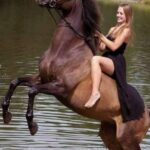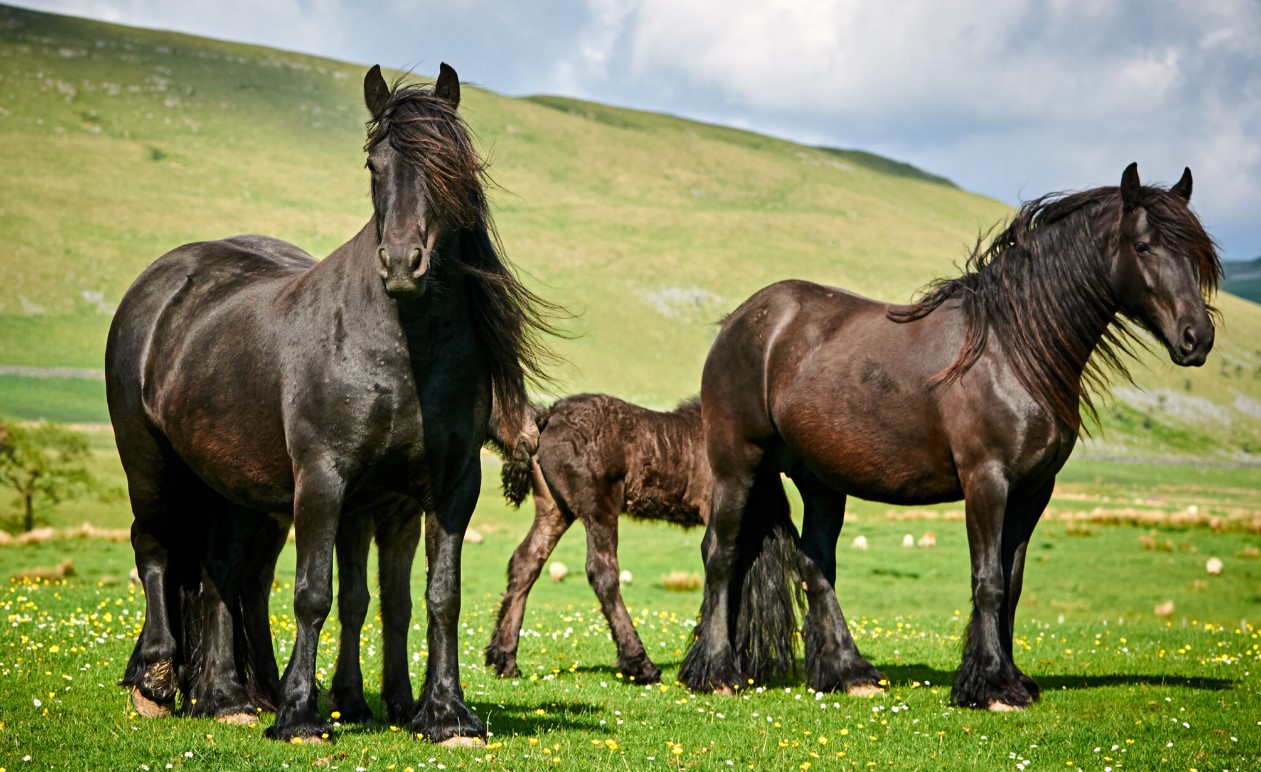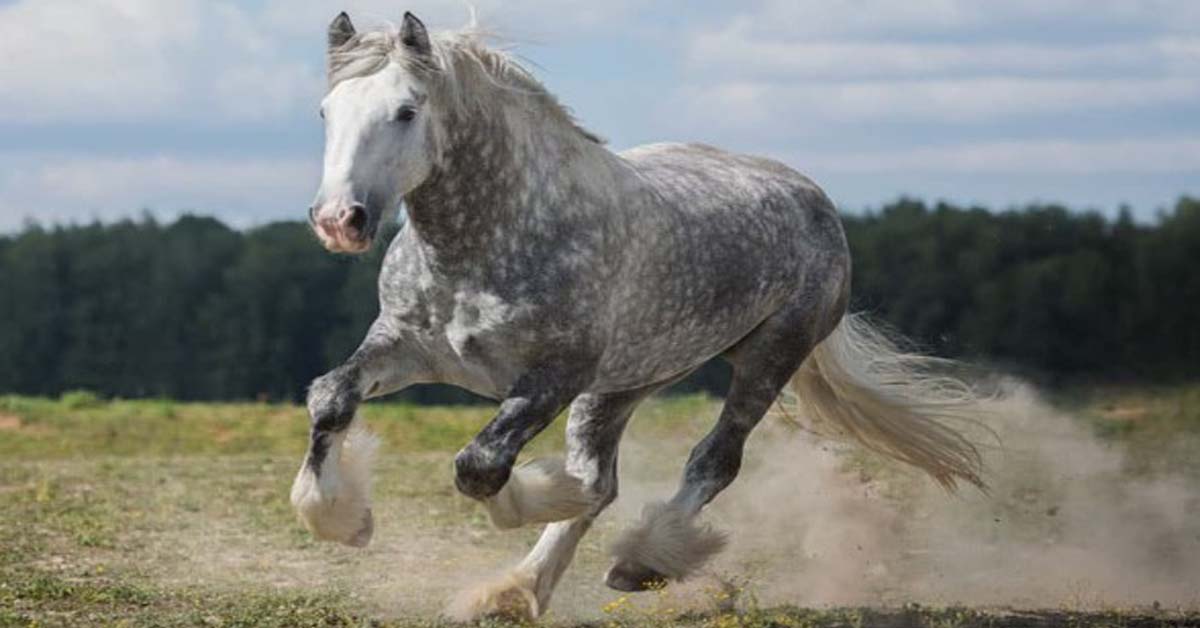Fell Pony
The Fell pony, hailing from the rugged fells and hills of Northern England, is a diminutive equine breed celebrated for its robust endurance. These hardy creatures find purpose in pony trekking and serve as diligent workhorses on agricultural estates. With their sturdy and compact physique, they sport a diverse array of hues, encompassing shades such as black, brown, and grey. Noteworthy for their affable and gentle disposition, the Fell pony holds the distinction of being classified as a “critical” breed by the American Livestock Breeds Conservancy.
Fell Pony Breed History
The Fell Pony shares its lineage with the now-extinct Galloway pony, which also contributed to the development of the Dales Pony. Its origins trace back to the borderlands of England and Scotland, a history likely predating even Roman times. The Fell Pony Society refrains from asserting any influence from imported Roman war stallions in their breeding with these ponies.
In the early stud records, approximately half of the ponies boasted a brown coat, but in recent decades, black has emerged as the dominant color, with brown, bay, and grey following suit.
This breed predominantly serves as a working pony, characterized by its activity, stamina, resilience, and intelligence. These qualities empower Fell Ponies to thrive in challenging conditions among the fells in the Lake District.
Use as Packhorses
The Fell Pony originally played a pivotal role as a packhorse, bearing loads of slate, lead, copper, and iron ores. They also found utility in light agricultural tasks and the transportation of bulky farm commodities like wool. Their robust physiques, sturdy legs, even temperament, and brisk walking pace enabled them to cover remarkable distances, sometimes traveling up to 240 miles (390 kilometers) per week.
Vikings held a particular fondness for Fell Ponies, employing them as packhorses, plow animals, mounts for riding, and for pulling sleds. Their service as pack ponies endured well into the 20th century when they continued to contribute to pack-pony caravans and postal services. Some Fell Ponies gained fame in the north for their swiftness as trotters, with tales recounting their remarkable speeds over long distances.
Breed Associations and Registries
United Kingdom
- The Fell Pony Society: www.fellponysociety.org.uk
United States
- Fell Pony Society of North America: www.fpsna.org
Description of the Fell Pony







HEIGHT: Not exceeding 14 hands (142.2 cms).
COLOUR & MARKINGS: Black, brown, bay and grey. Chestnuts, piebalds, and skewbalds will be registered in
section X. A star or white above lower eye level and white below nostrils and any white on the hind leg/hoof is acceptable.
An excess of white markings is discouraged, ie a blaze or stripe, or white below lower eye level and above nostrils and/or any amount of white on a front hoof or leg, but such ponies are eligible for registration in section X.
HEAD: Small, well-chiseled in outline, well set on, forehead broad, tapering to the nose.
NOSTRILS: Large and expanding.
EYES: Prominent, bright, mild, and intelligent.
EARS: Neatly set, well-formed, and small.
THROAT & JAW: Fine, showing no signs of throatiness or coarseness.
NECK: Of proportionate length, giving a good length of rein, strong and not too heavy, moderate crest in case of stallion.
SHOULDERS: Most important, well laid back and sloping, not too fine at withers, nor loaded at the points – a good long shoulder blade, muscles well developed.
CARCASE: Good strong back of good outline, muscular loins, deep carcase, thick through heart, round ribbed from shoulders to flank, short and well coupled, hind quarters square and strong with tail well set on.
FEET, LEGS, AND JOINTS: Feet of good size, round, and well-formed, open at heels with the characteristic blue horn, fair sloping pasterns not too long, forelegs should be straight, well placed not tied at elbows, big well-formed knees, short cannon bone, plenty of good flat bone below the knee (eight inches at least), great muscularity of arm.
HIND LEGS: Good thighs and second thighs, very muscular, hocks well let down and clean cut, plenty of bone below the joint, hocks should not be sickle nor cow-hocked.
MANE, TAIL, AND FEATHER: Plenty of fine hair at the heels (coarse hair objectionable), all the fine hair except that at the point of the heel may be cast in summer. The mane and tail are left to grow long.
ACTION: Walk, smart and true. Trot well balanced all around, with good knee and hock action, going well from the shoulder and flexing the hocks, not going too wide nor near behind. Should show great pace and endurance, bringing the hind legs well under the body when going.
GENERAL CHARACTERISTICS AND BREED TYPE: The Fell Pony should be constitutionally as hard as iron and show good pony characteristics with the unmistakable appearance of hardiness peculiar to mountain ponies, and at the same time, have a lively and alert appearance and great bone.
The aptly named Drybarrows Enigma – a rare chestnut Fell pony. Chestnut/red is not recognised in the breed yet purebred red Fells do appear. A recessive gene is responsible for red & can “hide” for generations seeming to appear randomly – in reality it’s been there all along pic.twitter.com/oqdhCC8iox
— Ruth Chamberlain (@RuthOnTheHoof) January 27, 2023
Read More About Other Hors Bread
Fell Pony For Sale
You Can Buy or Sell From Here: www.ehorses.com
A Guide to Training a Fell Pony
Training a Fell Pony closely resembles training other horses, but there are specific considerations to bear in mind when working with this breed.
- Commence early: Capitalize on the Fell Pony’s renowned intelligence and teachability by initiating training at a young age. This early start facilitates rapid learning and the formation of commendable behavior.
- Embrace positive reinforcement: Fell Ponies are responsive to positive reinforcement techniques, such as clicker training and treats. This approach fosters their motivation and engagement throughout the training process.
- Prioritize groundwork: Before progressing to riding, establish a solid foundation in groundwork. This involves imparting fundamental commands like leading, standing still, and backing up.
- Expose them to diverse environments: Given their adaptability, expose Fell Ponies to various surroundings and experiences. This broadens their horizons, promoting confidence and versatility.
- Exercise patience: While Fell Ponies are intelligent and eager to please, they can occasionally display stubbornness. Exercise patience and perseverance in your training, avoiding harsh methods.
- Maintain regular exercise: Recognize the athleticism of Fell Ponies and ensure they receive routine exercise to sustain their fitness and endurance. Activities may encompass trail rides, arena work, or even jumping.
- Commit to regular grooming and hoof care: Fell Ponies are distinguished by their thick, furry coats, making regular grooming essential for their appearance and well-being. Likewise, prioritize hoof care to ensure their health and soundness.
- Seek professional guidance when needed: If you’re new to horse training or encounter challenges with your Fell Pony, consider consulting a professional trainer or instructor. Their expertise will assist you in comprehending your pony’s needs and provide the tools for your training success.
Riding the Fell Pony in England
Tips for Grooming a Fell Pony
Grooming a Fell Pony is an important part of maintaining its health and appearance. Here are some tips to help you groom your Fell Pony effectively:
- Brush regularly: Fell Ponies have thick, hairy coats that require regular brushing to keep them tangle-free and shiny. Use a wide-toothed comb and a slicker brush to remove tangles and dirt, and a soft-bristled brush to finish and bring out the shine.
- Trim the mane and tail: Fell Ponies have long, thick manes and tails that can become matted if not trimmed regularly. Use scissors or thinning shears to trim the hair and keep it neat.
- Clean the ears: Fell Ponies have long, hairy ears that can trap dirt and debris. Use a damp cloth to clean the inside of the ears and remove any debris.
- Bathe your pony: Bathing your Fell Pony will help to remove dirt, sweat, and other debris from the coat. Use a mild shampoo specifically formulated for horses and rinse thoroughly to avoid skin irritation.
- Pick out the hooves: Regularly pick out the hooves and remove any dirt or debris that can cause thrush. This will help to keep them healthy and prevent lameness.
- Check for lumps or bumps: While grooming, check your pony’s skin for any lumps or bumps, and bring any concerns to the attention of your veterinarian.
- Check for parasites: Check your pony’s coat for any signs of parasites such as lice, ticks, or mites, and treat them promptly.
- Groom in a comfortable environment: Make sure your pony is comfortable, in a safe and well-ventilated area, and not in direct sunlight.
By following these tips, you can help to keep your Fell Pony looking and feeling their best.
Caring for a Fell Pony: A Comprehensive Guide
Fell Ponies, renowned for their rugged adaptability and native to England’s Lake District, are celebrated for their robustness, endurance, and adeptness in challenging terrain. Here’s an extensive guide to nurturing a Fell Pony:
Feeding: Provide Fell Ponies with a diet rich in roughage, including hay and grass, complemented by a modest amount of concentrate feed, such as oats or barley, to meet their nutritional needs. Ensure continuous access to clean, fresh water.
Exercise: Given their active nature, Fell Ponies require regular exercise to maintain their well-being. They can be ridden or driven, and they relish extended walks or runs in rural landscapes.
Grooming: Fell Ponies feature a dense double coat that necessitates regular grooming for both aesthetics and comfort. Daily brushing removes dirt, knots, and loose hair.
Hoof Care: The sturdy hooves of Fell Ponies should undergo consistent trimming and maintenance by a skilled farrier to keep them in prime condition.
Vaccinations and Health Care: Uphold a vaccination regimen to shield Fell Ponies from common equine ailments like tetanus. Regular veterinary check-ups are essential to monitor their health.
Shelter and Turnout: Furnish Fell Ponies with secure and safe living quarters, such as a stable or barn, alongside access to a fenced pasture for turnout.
Training and Behavior: These intelligent and eager-to-please ponies can exhibit a strong will at times. Employ positive reinforcement training techniques and commence early training and socialization to avert behavioral issues.
In sum, tending to a Fell Pony demands dedication, diligence, and patience. Yet, with attentive care and nurturing these hardy and versatile equines can bring immense joy and fulfillment as cherished companions and riding partners.
Fell Pony FAQs
Can you ride a Fell Pony?

Yes, it is possible to ride a Fell Pony, as they are a breed of pony that is known for their strength and endurance. They are often used for riding, as well as for driving and working on farms.
However, it is important to note that all horses, including Fell Ponies, have unique personalities and abilities, and it is important to match the pony with the rider’s skill level and experience.
Additionally, proper training and care should be given to any pony before it is ridden.
How long do Fell Ponies live?
Fell Ponies have an average lifespan of around 20-25 years. With proper care, nutrition and veterinary attention they can live beyond 25 years. It’s important to note that genetics, living conditions and overall management play a significant role in the life expectancy of any animal.
Are Fell Ponies good for kids?
Fell Ponies can make good mounts for children, as they are known for their calm and friendly dispositions. They are also known for their intelligence, which can make them easy to train and work with.
However, as with any horse, it is important to match the pony with the child’s skill level and experience. It is also important to ensure that the pony receives proper care, nutrition, and veterinary attention and that the child is supervised while riding. It’s important to note that even if a pony breed is known to have a good temperament, every horse is unique and their suitability for children needs to be evaluated individually.











